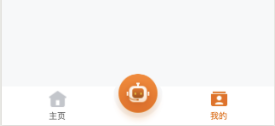遇到的一个需求是在tabbar上有一个凸起的小图标, 但是微信自带的tabbar是没有这个效果的, 无奈,只能使用自定义tabbar,查找了多方文档后发现大多是原生小程序实现, 关于taro文档的少之又少, 所以记录下来,方便下次查看。
该实现方式是借鉴了官方demo以及一位大佬关于原生小程序自定义tabbar的文章
官方demo传送门:自定义tabbar 文章传送门:点击此处
关于taro实现方式,我放在了github上:https://github.com/puerilexy/tabbarDemo
效果展示:(可以看到下面凸出的智能机器人图标)
第一步: 在app.js中的tabbar字段下指定custom: true,即为启用自定义tabbar
config = { pages: [ 'pages/index/index', 'pages/user/user', 'pages/intellect/intellect' ], window: { backgroundColor: '#f4f4f4', backgroundTextStyle: 'light', navigationBarBackgroundColor: '#fff', navigationBarTitleText: 'WeChat', navigationBarTextStyle: 'black' }, tabBar: { color: '#666', selectedColor: '#ed6c00', backgroundColor: '#fafafa', borderStyle: 'black', custom: true, list: [{ pagePath: 'pages/index/index', iconPath: 'assets/home.png', selectedIconPath: 'assets/home-active.png', text: '主页' }, { pagePath: 'pages/user/user', iconPath: 'assets/user.png', selectedIconPath: 'assets/user-active.png', text: '我的' }] } }
第二步:在src目录下新建custom-tab-bar文件夹(注意此文件夹和pages文件目录同级)
├── src ├── custom-tab-bar ├── index.js ├── index.scss ├── pages ├── index ├── user ├── intellect
在custom-tab-bar下的index文件中代码如下:
import Taro, { Component } from '@tarojs/taro' import { CoverView, CoverImage } from '@tarojs/components' import Intellect from '../assets/intellect.png' import './index.scss' class customTabBar extends Component { state = { selected: 0, color: '#666', selectedColor: '#ed6c00', list: [{ pagePath: '/pages/index/index', iconPath: '/assets/home.png', selectedIconPath: '/assets/home-active.png', text: '主页' }, { pagePath: '/pages/user/user', iconPath: '/assets/user.png', selectedIconPath: '/assets/user-active.png', text: '我的' } ] } switchTab = (item) => { const url = item.pagePath Taro.switchTab({ url }) } jumpIntellect = () => { Taro.navigateTo({url: '/pages/intellect/intellect'}) } componentDidMount() { this.setState({ selected: this.props.ind }) } // 自定义 tabBar的页面 render() { return ( <CoverView className='tab-bar'> <CoverView className='tab-bar-wrap'> { this.state.list.map((item, index) => { return <CoverView className='tab-bar-wrap-item' onClick={this.switchTab.bind(this, item)} data-path={item.pagePath} key={item.text} > <CoverImage className='tab-bar-wrap-item-icon' src={this.state.selected === index ? item.selectedIconPath : item.iconPath} /> <CoverView className='tab-bar-wrap-item-btn' style={{color: this.state.selected === index ? this.state.selectedColor : this.state.color}} >{item.text} </CoverView> </CoverView> }) } </CoverView> <CoverImage className='intellect-icon' src={Intellect} onClick={this.jumpIntellect} /> </CoverView> ) } } export default customTabBar
注意: 这里是我在华为手机测试中出现自定义的tabbar会跟随页面滚动而滚动, 在我选择了cover-view组件后解决了这一问题
另外如果中间的图标跳转为二级页面,则不需要配置在tabbar字段下。
第三步:分别在index合user文件中获取自定义tabbar组件实例,更新选中态(注意:原生小程序中可直接通过this.getTabBar直接获取,在taro中需要通过this.$scope.getTabBar来获取组件实例)
// index.js componentDidShow () { if (typeof this.$scope.getTabBar === 'function' && this.$scope.getTabBar()) { this.$scope.getTabBar().$component.setState({ selected: 0 }) } } // user.js componentDidShow () { if (typeof this.$scope.getTabBar === 'function' && this.$scope.getTabBar()) { this.$scope.getTabBar().$component.setState({ selected: 1 }) } }
到此,在微信小程序中自定义凸出图标的tabbar就完成了。
